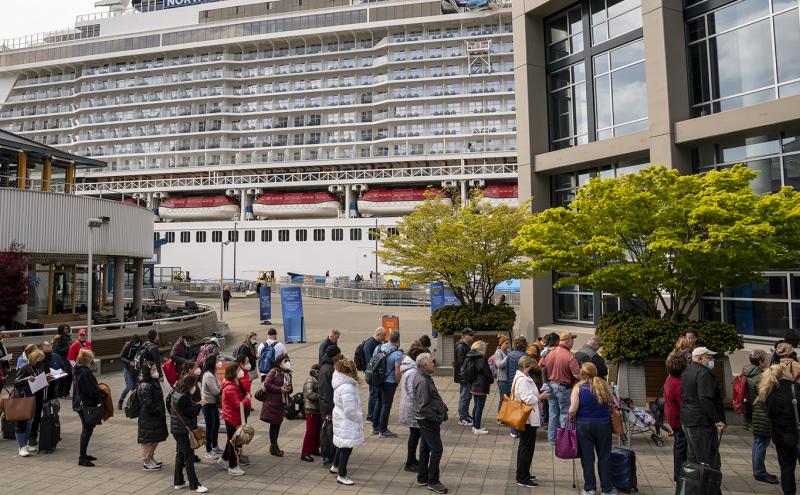
Just over 20 years ago the Port of Seattle developed a local cruise terminal to expand economic opportunity on our working waterfront and throughout the community. We also began setting goals to ensure that our cruise business aligned to the Port’s sustainability goals.
Since then we have made extraordinary progress, but by any measure this was a transformative year on both counts. The cruise season supported a significant regional economic recovery and made major advancements in sustainability. New job fairs and pre-season information sessions helped our community learn about and benefit from the upcoming cruise season. We will continue both of those best practices in 2023. Additionally, the faster-than-expected recovery of the Seattle-Alaska cruise itinerary allowed the Port to add another $2 million into funding for its Youth Career Launch Pilot program, now funded at $4.1 million for the next three years.
Reaching ambitious, long-term goals, such as becoming the greenest and most energy efficient port in North America, requires constant evaluation, collaboration, and innovation. We are pleased to provide this update on progress made by the Port, cruise industry, and our partners during the 2022 season.
Decarbonizing maritime industries
The Port of Seattle set a goal to phase out its own emissions by 2040 and to support carbon neutral industries by 2050. To help reach that goal, this year we joined Alaskan and Canadian port leaders, cruise industry partners, and environmental experts in launching a first-of-its kind collaborative effort to explore the feasibility of a maritime Green Corridor focused on cruise ships. The effort is aimed at accelerating cruise decarbonization through the deployment of low and zero greenhouse gas emission solutions between Alaska, British Columbia, and Washington. Learn about our partners and work at our Green Corridor webpage.
We intend to make our region a testbed for maritime innovation and decarbonization. Maritime industries and partners nearly doubled the number of zero emission shipping projects around the world this year. We are eager to bring these innovative programs and technologies to our communities (examples include cruise ship methanol fuel tests, biofuel bunkering on large cruise ships, and for zero-emission coastal cruise ships).
We also see potential to benefit from global innovation in green hydrogen. In October 2022, the Port of Rotterdam, one of Seattle’s sister ports, and a Madrid-headquartered energy firm Cepsa announced a project to establish a green hydrogen supply chain between southern Spain and Europe’s largest port. This example demonstrates how a port can lead the transition to a clean fuel economy.
The Port of Seattle expanded our work this year to explore green hydrogen as a future source of fuel for maritime industries. In addition to studies that launched late last year, in 2022 the Port and maritime industry leaders submitted projects in response to a United States Department of Energy Request for Information. The Port is also engaged in the development of a regional green hydrogen hub through the Pacific Northwest Hydrogen Association.
The Port of Seattle already provides clean, electric shore power to properly equipped cruise ships berthed at Terminal 91. The Port has been working to overcome challenges to bringing sufficient electricity to the Pier 66 cruise berth. That project should be completed in 2024, making the Port of Seattle one of the only cruise homeports in North America with three shore power enabled cruise berths.
We are also working collaboratively with Ports around the world to look for ways to build off each other’s efforts. We set a goal to achieve a 100 percent shore power connection rate by all homeport cruise ships by 2030. In the past year, we reached new milestones in our work as a member of the International Association of Ports and Harbors, to establish a global incentive program for cruise ship that adopt specific sustainability practices, which we are working to bring to Seattle.
Clean water for Puget Sound
Since 2004 the Port has partnered with Washington State Department of Ecology and the cruise industry in a voluntary agreement, called the Memorandum of Understanding Cruise Operations in Washington State, which has reduced and ultimately eliminated wastewater discharges from large cruise ships into state waters. Cruise lines participated in that program for a decade before Washington law turned Puget Sound into a “no discharge” zone for all maritime vessels.
The “no discharge” zone prevents the discharge of sewage, whether treated or not. It does not include the discharge of regulated exhaust gas cleaning system wash water, which is separately managed by the Environmental Protection Agency and U.S. Coast Guard.
Starting in 2021, all cruise lines voluntarily agreed to pause all discharges of exhaust gas cleaning system wash water in Puget Sound. Carnival Corporation began to work with a third-party researcher, Port of Seattle, and Washington Department of Ecology to sample wash water from cruise ships and conduct a scientific analysis of any water quality impacts on the health of Puget Sound.
This past summer, researchers at Oregon State University, alongside third-party observers, collected underway water samples to begin that analysis. The findings of this study are expected before the start of the 2023 cruise season, will be made public, and used to guide future practices.
This season we tackled cross-border initiatives and local sustainability with more projects and programs than ever in the Port’s history. It is exciting to be a part of the global and local movements focused on maritime sustainability. Thank you to the staff and partners who make this progress possible.








